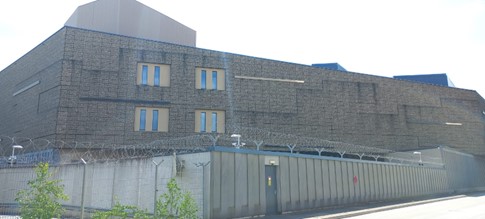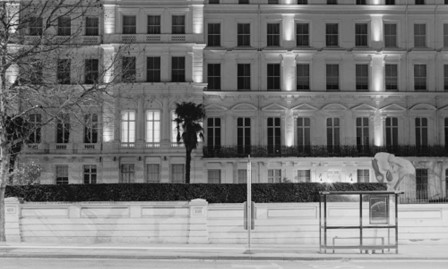Libertecture: A catalogue of libertarian spaces
- Created
- 24 Jul 2023, 10:56 a.m.
- Author
- Rowland Atkinson and Liam O'Farrell
We started writing this article by observing what appeared to be more or less concealed aspects of cities that were suddenly becoming more prominent. We were surrounded by stories of what AI and robots were doing for cities, the UK had recently seen the creation of a series of freeports modelled on low tax and regulation models elsewhere, billionaires were trying to fly to the Moon or Mars and were inviting experts to private discussions about the future of national economies. There was a sense of a broad set of ideas connected to notions of freedom, personal ability, and the avoidance of state interference becoming more widely shared and of interest to younger people, who saw only drudgery in the gig economy and insecurity elsewhere.

Fiscal locker room: A freeport infrastructure (Picture: Liam O’Farrell)
Many in governments around the world were denigrating public services and dismantling or defunding them while citizens clamoured for more and better forms of investment. A shining and inviting public realm of the wealthy could be contrasted with a decaying public realm – a grounded poverty and immobility that resonated with lockdown urbanism and a free floating world of winners using buildings like Geneva’s Freeport, the metaverses’ Liberland utopia and the ultrathin towers of New York’s West 57th Street. Libertarian thinking was, while not dominating our cities, becoming a more constant bedfellow in the wagons-lit of our travels toward an uncertain social future.

Necrotecture: Unused residential space in London (Picture: Alan Silvester)
Libertecture was the neologism coined by us by which we sought to connect the idea of freedom and libertarian thinking with the built environments being constructed today and planned for the future. The article is really an attempt to think this possibility through. Firstly, by discussing how identifiable clusters of ideas and ideologies might be represented or embodied in the built environment. Second, by examining how libertarianism as a rising ideological ‘space’ is evident in cities around the world. We looked at seasteading, the charter city movement gaining some ground in parts of Africa, the plans for the 150km long strip of Saudi Arabia’s Neom, the bunkers of New Zealand and billionaire wildernesses of the USA. These were spaces built to privilege ideas of personal freedom, ultra-commitments to market principles, and the avoidance of commitment to others except insofar as they might form a means of personal advance. We were pushing the sense that there were threads connecting the kind of libertarianism advanced by the Thiels, Sunaks and Musks of this world, alongside other cultural currents stemming from Randian thinking or the aesthetics of video games like Bioshock or Grand Theft Auto.

Private city: 150km path of Neom, Saudi Arabia (Picture: European Space Agency)
We feel that the main value of the article is its outline of a ‘catalogue’ of spatial types – offering a kind of vocabulary of terms that can be used to describe the different subtypes of libertecture itself: private cities, residential exits, portal spaces, fiscal lockers, pioneer exclaves, infinity spaces, and necrotectures. This catalogue started as a kind of dark version of the Whole Earth Catalogue which had celebrated the counterculture and ecological awareness. On reading around the idea of the Dark Enlightenment, we felt that this could be related to forms of urbanism, or components of city life, that were more or less oppositional to ideas of a public city, to social contribution and to common cause or support in urban life which could be found in libertecture’s main exemplars. Another thing that drove our writing was a sense that libertecture may help to act as a beacon for those attracted to libertarian thinking. The result is a political article in the sense that we hope it will be read by students of a future urban world who are concerned that libertecture forms only a very small part of it.
Read the accompanying article on Urban Studies OnlineFirst here.


Comments
You need to be logged in to make a comment. Please Login or Register
There are no comments on this resource.